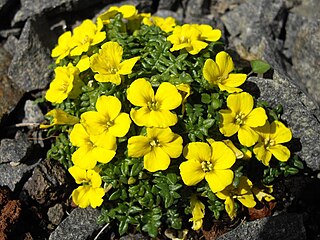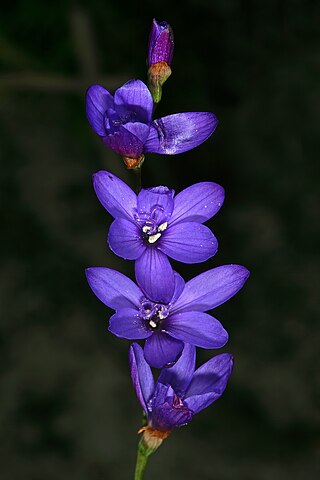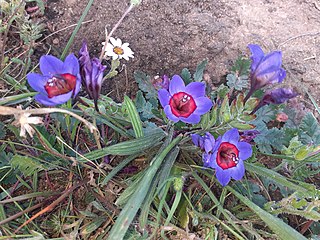
Iridaceae is a family of plants in order Asparagales, taking its name from the irises. It has a nearly global distribution, with 69 accepted genera with a total of c. 2500 species. It includes a number of economically important cultivated plants, such as species of Freesia, Gladiolus, and Crocus, as well as the crop saffron.

Anacyclus is a genus of plants in the family Asteraceae described by Linnaeus in 1753. Annuals or herbaceous perennials, they are cultivated for their fern-like leaves on creeping, radiating stems and daisy-like flowers. They are frost-hardy but may tolerate winter temperatures below −5 °C (23 °F) if grown in well-drained soil.

Charles Wright was an American botanist.

Morisia is a monotypic genus of ornamental plant in the family Brassicaceae. Its only species is Morisia monanthos, also called M. hypogaea. It is native to the Mediterranean islands of Corsica and Sardinia.

Geissorhiza is a genus with 103 species described to date of deciduous perennial flowering plants in the family Iridaceae first described as a genus in 1803. The entire genus is endemic to Cape Province of western South Africa. The genus name is derived from the Greek words geisson, meaning "tile", and rhizon, meaning "root".

Crocoideae is one of the major subfamilies in the family Iridaceae.
Bulbophyllum monanthos is a species of orchid in the genus Bulbophyllum.

Uitkamp Wetland Nature Reserve is a 32-hectare (79-acre) wetland reserve located in Durbanville in the Western Cape province of South Africa.

Dendrobieae is a tribe in the subfamily Epidendroideae, in the family Orchidaceae. The Dendrobieae are mostly tropical, epiphytic orchids which contain pseudobulbs.

Geissorhiza radians or winecup flower is a highly threatened species from the Iris family with fewer than 10 remaining sub-populations growing in south-western Cape, South Africa. The deep purple flowers with large, red centres grow is dense colonies which makes for a spectacular flower displays from mid-September, particularly around the town of Darling. Its seasonally wet lowlands habitat is however becoming increasingly threatened with more than 80 % of its original habitat now permanently transformed into agriculture or urban sprawl and the remaining populations threatened by encroaching invasive alien vegetation and fertilizer runoff. The dark-centred flowers aim to attract specific pollinators from the horsefly family (Tabanidae), but the specific interactions still require additional investigation.

Geissorhiza ovata is a species of flowering plant in the family Iridaceae. It is found growing on stone ridges and rock outcrops in the Northern Cape Province of South Africa.

Geissorhiza aspera, also know as the blue satin flower or blou sysie, is a geophyte from South Africa.
Gwendoline Joyce Lewis (1909–1967) was a South African botanist.

Geissorhiza melanthera is a small perennial plant of 14–18 cm high that is assigned to the family Iridaceae. It survives the dry southern summer through storage of its resources in a corm. The stem carries two or three erect, sticky leaves of up to 18 cm (7 in) long, H-shaped in cross-section. This species blooms with six to twelve bilaterally symmetrical flowers, in a spike. Sometimes the spike has one side branch with fewer flowers. Each flower has six pale beige perianth lobes, a purple-red ring around a purple red tube and three blackish stamens. Each flower is subtended by two 1.25–2.25 cm long green bracts. This species flowers from the end of September till mid October. It is an endemic of the western slopes of the Piketberg mountains in the Western Cape province of South Africa.

Joseph William "Jimmy" Mathews was a horticulturist and gardener from England who served as the first curator of the Kirstenbosch national botanical garden in Cape Town, South Africa.

Oreojuncus is a small genus of flowering plants in the rush family Juncaceae, found in the eastern United States, eastern Canada, Greenland, Iceland, the Faroes, most of Europe, northern Russia, western Siberia and the Altai. Their chromosome number is 2n=30 (x=15), whereas Juncus, from which they were split, has x=20.
Sphaerospora may refer to:

Babiana rubrocyanea is a perennial geophyte of 5–15 cm (2.0–5.9 in) high, with entire, lance-shaped, hairy, pleated leaves and flowers that have a narrowly funnel-shaped tube at their base and six free tepal lobes at the top that form a wide cup that is purplish blue with a sharply defined carmine red centre. It can be found in a small area of the Western Cape province of South Africa. Flowers can be found from August to the middle of September. It is called blue-and-red babiana in English and rooibloubobbejaantjie in Afrikaans.

Geissorhiza splendidissima, the blue pride-of-Nieuwoudtville, is a plant species of geophyte in the family Iridaceae. It is endemic to Nieuwoudtville in the Northern Cape of South Africa. It is also called the Bokkeveld pride and splendid satin.















